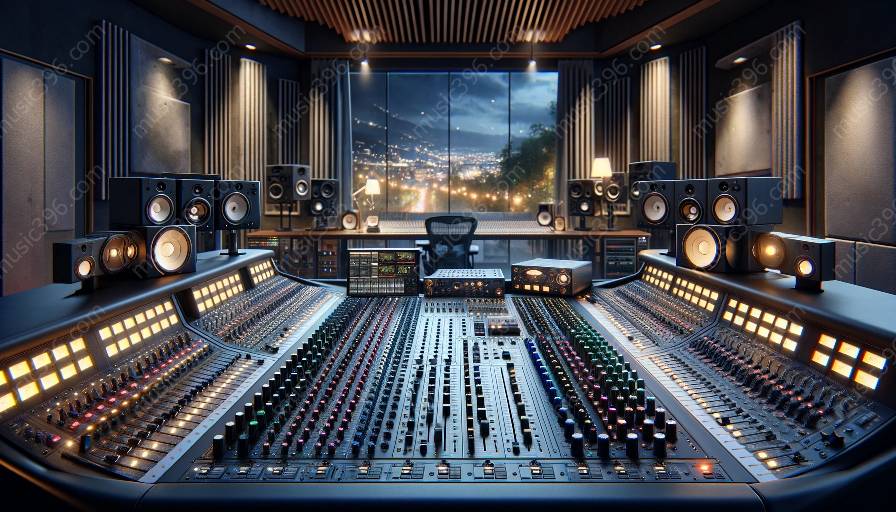Studio equipment selection and setup are vital aspects of creating a professional and effective environment for audio and sound engineering. The careful selection and proper setup of studio equipment can significantly impact the quality of the final output and the overall efficiency of the process.
When it comes to audio engineering, the right choice of studio equipment and its configuration can make all the difference in the production of high-quality audio content. From microphones and preamps to monitors and mixers, every piece of equipment plays a crucial role in shaping the sound. In the realm of sound engineering, the equipment setup is essential for capturing, processing, and reproducing sound accurately and with the desired artistic intent.
Key Considerations for Studio Equipment Selection
Before embarking on the selection and setup of studio equipment, it is essential to consider several critical factors that can influence the process. These considerations include:
- Technical Requirements: Understanding the technical specifications and requirements of the audio and sound engineering projects is paramount. Factors such as frequency response, dynamic range, and signal-to-noise ratio need to be taken into account when selecting studio equipment.
- Budget Allocation: Setting a realistic budget for studio equipment is crucial. It is essential to balance the cost of the equipment with its performance and suitability for the intended tasks.
- Room Acoustics: The acoustics of the studio space play a significant role in the selection and setup of equipment. Factors such as room dimensions, wall surfaces, and acoustic treatment need to be considered to ensure optimal sound quality.
- Scalability: Planning for future expansion and scalability of the studio setup is important. Investing in equipment that can accommodate future growth and technological advancements can save time and resources in the long run.
Types of Studio Equipment
Studio equipment encompasses a wide range of devices and hardware that contribute to the audio and sound engineering process. Some of the essential types of studio equipment include:
- Microphones: Microphones are fundamental tools for capturing sound and are available in various types such as condenser, dynamic, and ribbon microphones. The choice of microphone depends on the specific recording and sound reinforcement requirements.
- Preamps: Preamps amplify the low-level signals from microphones and instruments to line level for further processing. High-quality preamps can significantly enhance the sonic character of audio recordings.
- Audio Interfaces: Audio interfaces serve as the bridge between analog and digital systems, allowing for the connection of microphones, instruments, and monitor speakers to a computer for recording and playback.
- Studio Monitors: Studio monitors are critical for accurate audio reproduction and monitoring. They are designed to provide a flat frequency response to help engineers make informed decisions about the sound mix.
- Outboard Gear: Outboard gear such as compressors, equalizers, and reverbs offer additional processing capabilities to shape and enhance the audio signal during recording and mixing.
Optimizing Studio Equipment Setup
Once the studio equipment has been selected, the next crucial step is to optimize its physical setup to ensure efficient and effective operation. The following best practices can help in optimizing the studio equipment setup:
- Placement and Ergonomics: Proper placement of studio equipment, including monitors, consoles, and outboard gear, is essential for a comfortable, ergonomic workflow. Arranging equipment in an intuitive and accessible manner can enhance productivity and reduce the risk of physical strain.
- Cable Management: Maintaining a clean and organized cable management system is vital to prevent signal interference, tripping hazards, and equipment damage. Using cable trays, ties, and labels can streamline the setup and troubleshooting process.
- Acoustic Treatment: Incorporating acoustic treatment solutions such as absorbers, diffusers, and bass traps can help in controlling room reverberation, reflections, and standing waves, leading to improved accuracy in sound monitoring and recording.
- Power Conditioning: Using power conditioners and surge protectors can safeguard studio equipment from electrical interference, voltage fluctuations, and power surges, ensuring stable and reliable operation.
- Calibration and Testing: Regular calibration and testing of studio equipment, including monitors, microphones, and signal processors, can help maintain their optimal performance and accuracy over time.
Conclusion
Studio equipment selection and setup are integral parts of creating a conducive environment for audio and sound engineering. By carefully considering the technical requirements, budget allocation, room acoustics, and scalability, engineers can make informed choices in selecting the right equipment. Understanding the types of studio equipment and optimizing their setup through proper placement, cable management, acoustic treatment, power conditioning, and calibration can elevate the quality of audio production and improve workflow efficiency.


























